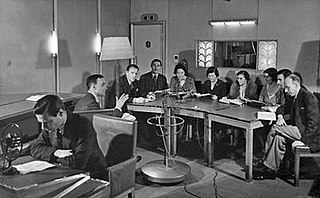A television network or broadcaster is a telecommunications network for distribution of television program content, whereby a central operation provides programming to many television stations or pay television providers. Until the mid-1980s, television programming in most countries of the world was dominated by a small number of terrestrial networks. Many early television networks evolved from earlier radio networks.

WMYA-TV, virtual channel 40, is a MyNetworkTV-affiliated television station licensed to Anderson, South Carolina, United States, serving Upstate South Carolina and Western North Carolina. The station is owned by Cunningham Broadcasting; the Sinclair Broadcast Group, which owns Asheville, North Carolina-licensed ABC affiliate WLOS, operates WMYA-TV under a local marketing agreement (LMA). However, Sinclair effectively owns WMYA-TV as the majority of Cunningham's stock is owned by the family of deceased group founder Julian Smith. The two stations share studios on Technology Drive in Asheville; WMYA-TV's transmitter is located in Fountain Inn, South Carolina.

KSL-TV, virtual channel 5, is an NBC-affiliated television station licensed to Salt Lake City, Utah, United States. It is the flagship television property of Bonneville International, the for-profit broadcasting arm of The Church of Jesus Christ of Latter-day Saints, and is a sister station to KSL radio. The three stations share studios at the Broadcast House building in Salt Lake City's Triad Center; KSL-TV's transmitter is located on Farnsworth Peak in the Oquirrh Mountains, southwest of Salt Lake City. The station has a large network of broadcast translators that extend its over-the-air coverage throughout Utah, as well as portions of Arizona, Idaho, Nevada and Wyoming.
CBC Television is a Canadian English-language broadcast television network that is owned by the Canadian Broadcasting Corporation, the national public broadcaster. The network began operations on September 6, 1952. Its French-language counterpart is Ici Radio-Canada Télé.
An independent station is a type of television station broadcasting in the United States or Canada that is not affiliated with any broadcast television network; most commonly, these stations carry a mix of syndicated, brokered and in some cases, local programming to fill time periods when network programs typically would air. Stations that are affiliated with networks such as The CW, MyNetworkTV or to a lesser degree, even Fox may be considered to be quasi-independent stations as these networks mainly provide programming during primetime, with limited to no network-supplied content in other time periods.
Television in Canada officially began with the sign-on of the nation's first television stations in Montreal and Toronto in 1952. As with most media in Canada, the television industry, and the television programming available in that country, are strongly influenced by media in the United States, perhaps to an extent not seen in any other major industrialized nation. As a result, the government institutes quotas for "Canadian content". Nonetheless, new content is often aimed at a broader North American audience, although the similarities may be less pronounced in the predominantly French-language province of Quebec.

KPTV, virtual and VHF digital channel 12, is a Fox-affiliated television station licensed to Portland, Oregon, United States. The station is owned by the Meredith Local Media subsidiary of Des Moines, Iowa-based Meredith Corporation, as part of a duopoly with Vancouver, Washington-licensed MyNetworkTV affiliate KPDX. Although the two stations share studios on NW Greenbrier Parkway in Beaverton and transmitter facilities in the Sylvan-Highlands section of Portland, master control and some internal operations are based at Meredith's West Coast hub facility at the studios of CBS-affiliated sister station KPHO-TV in Phoenix, Arizona.
An epilogue or epilog is a piece of writing at the end of a work of literature, usually used to bring closure to the work. It is presented from the perspective of within the story. When the author steps in and speaks directly to the reader, that is more properly considered an afterword. The opposite is a prologue—a piece of writing at the beginning of a work of literature or drama, usually used to open the story and capture interest. Some genres, for example television programs and video games, call the epilogue an "outro" patterned on the use of "intro" for "introduction".

WUNI, virtual channel 66, is an Univision-owned television station serving Boston, Massachusetts, United States that is licensed to Marlborough. The station is owned by the Univision Local Media subsidiary of Univision Communications, as part of a duopoly with Derry, New Hampshire-licensed Justice Network affiliate WWJE-DT ; Entravision Communications, which owns Worcester, Massachusetts-licensed UniMás affiliate WUTF-TV, operates WUNI under a joint sales agreement (JSA). WUNI and WWJE share studios and transmitter facilities on Parmenter Road in Hudson; under the JSA, master control and some internal operations of WUNI are based at WUTF's studios on 4th Avenue in Needham.
WHMB-TV, virtual channel 40, is a religious independent television station licensed to Indianapolis, Indiana, United States. The station is owned by the Family Broadcasting Corporation. WHMB's studios are located on Greenfield Avenue in Noblesville, and its transmitter is located on Walnut Drive in northwestern Indianapolis. On cable, WHMB is available on Comcast Xfinity channel 9, Charter Spectrum channel 22 and AT&T U-verse channel 40.
KPXE-TV, virtual channel 50, is an Ion Television owned-and-operated station licensed to Kansas City, Missouri, United States and serving the Kansas City metropolitan area. The station is owned by West Palm Beach, Florida-based Ion Media Networks. KPXE's offices are located on Oak Street and Cleaver Boulevard in Kansas City, Missouri, and its transmitter is located in the city's Brown Estates section. The station also serves as the de facto Ion outlet for the St. Joseph market.

WGGS-TV, virtual channel 16, is a religious independent television station licensed to Greenville, South Carolina, United States, serving Upstate South Carolina and Western North Carolina. Owned by Carolina Christian Broadcasting, it is a sister station to Hendersonville, North Carolina-licensed low-powered GEB America affiliate WDKT-LD. The two stations share studios on Rutherford Road in Taylors, South Carolina; WGGS-TV's transmitter is located at Paris Mountain State Park.
WCPX-TV, virtual channel 38, is an Ion Television owned-and-operated station licensed to Chicago, Illinois, United States. The station is owned by West Palm Beach, Florida-based Ion Media Networks. WCPX-TV's offices are located on Des Plaines and Van Buren Streets in the Chicago Loop, and its transmitter is located atop the Willis Tower on South Wacker Drive in the Loop.

WFXR, virtual channel 27, is a Fox-affiliated television station licensed to Roanoke, Virginia, United States and also serving Lynchburg. The station is owned by Nexstar Media Group, as part of a duopoly with Lynchburg-licensed CW affiliate WWCW. The two stations share studios at the Valleypointe office park on Valleypoint Parkway in Hollins ; WFXR's transmitter is located on Poor Mountain in unincorporated southwestern Roanoke County.

ONTV was an American subscription television service that was owned by National Subscription Television, a joint venture between Oak Industries and Chartwell Enterprises. Operating in such major markets as Los Angeles, Chicago, Minneapolis, Phoenix and Detroit, ONTV aired a broad mix of feature films from mainstream Hollywood blockbusters to pornographic films as well as sports events and specials.
A regional variation generally refers to times when a radio station or television station simultaneously broadcasts different programmes, continuity or advertisements to different parts of its coverage area. This may be so as to provide programming specific to a particular region, such as local news or may be so as to allow advertisements to be targeted to a particular area.

A broadcast relay station, also known as a satellite station, relay transmitter, broadcast translator (U.S.), re-broadcaster (Canada), repeater or complementary station (Mexico), is a broadcast transmitter which repeats the signal of a radio or television station to an area not covered by the originating station. It expands the broadcast range of a television or radio station beyond the primary signal's original coverage or improves service in the original coverage area. The stations may be used to create a single-frequency network. They may also be used by an FM or AM radio station to establish a presence on the other band.

The Epilogue was a feature of BBC radio and later television being the last programme broadcast each Sunday evening lasting five to ten minutes and being based on a non-denominational reflective theme usually delivered by a Christian minister or priest in a straight to-camera talk. In British television terminology, an "epilogue" is an equivalent of the American sermonette. Later the format was adopted by the independent television broadcaster ITV and its franchises including Scottish Television and Southern Television.
E!, also referred to as E! Entertainment Television, was a Canadian English language privately owned television system. It operated from 2001 to 2009 under the ownership of Canwest. At its peak it consisted of eight local television stations located in Quebec, Ontario, Alberta and British Columbia, including five stations owned and operated (O&O) by Canwest and three affiliates owned by Jim Pattison Group.
A sign-on is the beginning of operations for a radio or television station, generally at the start of each day. It is the opposite of a sign-off, which is the sequence of operations involved when a radio or television station shuts down its transmitters and goes off the air for a predetermined period; generally, this occurs during the overnight hours although a broadcaster's digital specialty or sub-channels may start up and closedown at significantly different times as its main channels.








